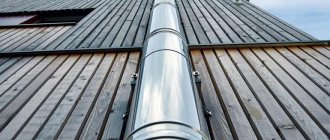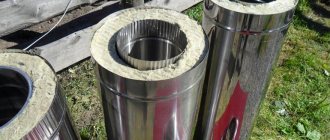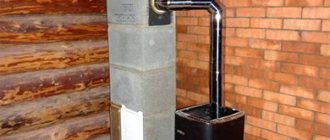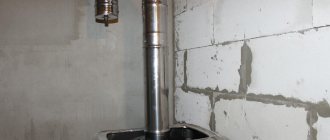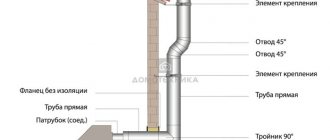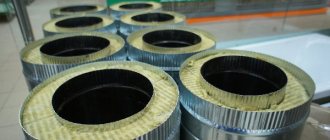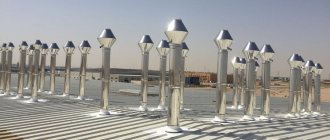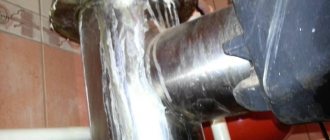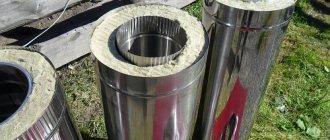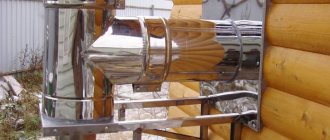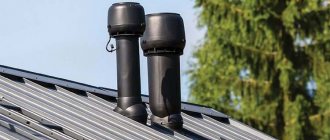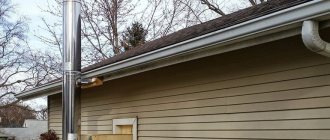Each room that is equipped with a boiler using liquid, solid or gaseous fuel must be equipped with a chimney. With its help, combustion products are released into the atmosphere without causing danger to people. Today, so-called sandwich chimneys have become very popular. Their main two features are ease of installation and disassembly.
It should be noted that sandwich chimneys are ordinary metal pipes that have been improved. A sandwich chimney consists of several pipes that are placed one inside the other. Insulation is placed between pipes of different diameters.
Sandwich. Appearance.
A sandwich chimney on a house is not only a useful element, but also perfectly decorates the house. Like any thing, such devices have positive and negative properties. Of course, there are much fewer disadvantages. However, they require special attention.
How a chimney became a sandwich
There was a time when the word “sandwich” brought to mind only gastronomic associations. Today, some visitors to construction stores are familiar with the features of double-walled chimneys, while others have a very vague idea about them. The idea of using two layers of steel separated by thermal insulation seems simple, but it was a long road to get there.
For centuries, the main type of chimney was the brick shaft. Its rectangular or square shape was, rather, a forced decision, and the limiting factor was the characteristics of the material. The widespread use of round chimneys became possible relatively recently, and the impetus was the development of technology and the emergence of new materials.
The round shape made it possible to reduce the size of the chimney. This was a solution that brought several improvements at once:
- The size of the chimney has decreased , it has become compact and no longer clutters up the space.
Compactness is an important advantage Source vacasol.dk
- It takes less time to clean a round shaft . The corners of brick shafts are areas where soot readily lingers, accumulates and, on occasion, is ready to catch fire. Round structures with their smooth metal walls significantly reduce the likelihood of fire.
- The round shape of the pipe improved traction . The combustion process became more uniform, and heat stopped flying out of the house into the chimney.
Of course, no form of pipe can completely relieve owners of all problems. Interesting fact: if the chimney is poorly cleaned, it will only loosen the soot and contribute to its ignition; it can ignite from any spark.
The three-layer design really resembles a sandwich filled with insulating material. Most buyers believe that the main goal of such a structure is to reduce heat, and, therefore, the likelihood of fire. In fact, this function, although important, is secondary. The main purpose of a sandwich chimney is to reduce the formation of condensation during operation.
Condensation on the chimney eventually destroys the entire structure Source schiedel.com
Chimney system configuration
The chimney design must be designed in such a way that its main part lies inside the heated room. Thanks to this, it is possible to speed up the heating of the smoke channel, minimize the appearance of condensation and significantly increase the efficiency of the heat generator.
If several stoves are installed in a room, then a separate smoke exhaust duct must be laid for each of them.
Please note that the main chimney must be installed vertically. There are situations when, due to the design of the building, a double deviation of the channel from the vertical line by up to 30° is allowed, while the distance of the pipe should not exceed 1 meter.
The connecting smoke duct is that part of the chimney that runs horizontally from the heat generating unit to the main smoke duct. The length of the connecting channel for furnaces should not be more than 1 meter, and for other heat generators - no more than 3 m. If it was decided to make the channel length greater than the specified values, the quality of traction should be checked. If the length of the channel exceeds 2 meters, it must be equipped with an inspection.
Picture Installation of revision
IMPORTANT! For safety reasons, smoke ducts must be located at some distance from electrical wiring, gas lines and other communications.
The total height of the chimney duct (from the grate to the mouth of the chimney) must be at least 5 meters. Fulfillment of this condition guarantees the required vacuum and excellent traction. It is also possible to operate lower chimneys, provided that they are installed in buildings that do not have an attic and provide an acceptable level of draft.
According to the standards, smoke ducts can have no more than 3 bends, and the turning radius should not be less than the diameter of the pipe.
Why is stainless steel needed?
The second half of the 20th century gave the world many new building materials that pushed the industry forward. It is not surprising that the round shape was not the only innovation in improving chimney systems.
For the role of the best material for the chimney, steel grades with different properties were tried, until the choice was made in favor of stainless steel. This became the same logical solution as the round shape of the chimney.
The reason for choosing stainless steel was its heat resistance. The flue gases that are formed during the combustion process have a high temperature. Its value can reach 800, and sometimes 1000 °C. For comparison, 50°C is enough to get a burn.
The inner tube of the sandwich resists not only extreme temperatures, but also condensation. In turn, its heat-insulating layer also needs protection from accidental mechanical impact and weather factors. Therefore, the design was supplemented with an outer layer of metal.
Chimney on the rear facade of the house Source schiedel.com
During operation, the outer pipe does not experience extreme loads; The degree of heat resistance of the steel from which it is made does not play any role. Therefore, steel of lower quality and composition is used for the outer shell than for the inner contour.
Compliance with fire safety
Even with good thermal insulation, strong heating of the outer surface of the chimney cannot be avoided. Temperatures of 300 degrees can easily ignite dry wood. Therefore, the process of constructing a structure made of sandwich pipes requires strict adherence to fire safety regulations:
Do not install the device near flammable materials. Such a system should be located at a distance of 25 cm from any flammable surface
If the heating temperature is lower, this gap can be reduced, but it is important that it remains within 10 cm. Air is considered the best thermal insulation. There is no need to fill the box through which the smoke channel passes with expanded clay or fill it with mineral wool. When installing such a structure on the roof, in addition to heating the pipe, it is necessary to take into account the direction of the flow of hot air and flying sparks. The elevation of the cylindrical product above the ridge, if the roof is made of fire hazardous material, must be more than 1 m.
Reliability and safety of the chimney: what to look for
For the operation of a chimney, the most important qualities are reliability and safety. If the system does not meet these requirements, it cannot be installed. It’s like building a house without a foundation - no matter how beautiful it is, unfortunately, you won’t be able to live in it.
The heating device together with the chimney system is a utility network. Therefore, you need to choose it based not on a beautiful picture or an attractive price. The ideal option would be if the selection is carried out by a professional.
Charring of the chimney passage due to improper installation Source schiedel.com
The following advice will be useful. If you select a chimney system yourself, be sure to ask the manufacturer for test certificates. It wouldn’t hurt to ask about practical things, for example, what should be the gaps between the pipe and combustible materials (fireproof offsets).
Fire safety requirements (dimensions of grooves and setbacks) are listed in SP 7.13130.2013, clause 5.27 (Heating, ventilation and air conditioning.). It also states that all indents for heat-generating devices and factory-made smoke ducts are made on the basis of the technical documentation of the manufacturer.
In other words, the manufacturer is responsible for your safety. If the documentation does not contain the necessary information, and when purchasing you are not given a clear answer (it gets confused, names different values), this is a reason to be wary. Most likely, no tests have been carried out, safety standards are unknown, and the responsibility for your health and life falls on your shoulders.
A safe chimney is not only beautiful, but also has a test certificate Source asb-portal.cz
See also: Catalog of house projects with a fireplace - from companies represented at the Low-Rise Country exhibition
Types of sandwich pipes for baths
A sandwich pipe for a bath consists of two pipes of different diameters inserted into one another. The gap between them is filled with a heat-insulating substance. The heat insulator can be mineral wool, asbestos, expanded clay or any other heat insulator that can withstand temperatures above 800°C. Sandwich pipes come in different diameters, and there are also different thicknesses of the thermal insulation layer.
Sandwich pipes are made 1 meter long. This is convenient: by selecting/manufacturing the necessary elements, you can easily assemble the required chimney configuration. Such sections are easy to install - they are easy to lift, install and adjust their position.
Pieces of sandwich pipes are connected to each other so that the upper pipe fits onto the lower
Pay attention to this! Not the other way around. To make it easier to assemble everything, one side is made with a slightly smaller diameter
This can be done by reducing the diameter by rolling or by forming a corrugated edge
Which one you choose - it is not so important that you need to fulfill one condition - the tightness of the connection
Sandwich pipes for a bath made of polished stainless steel
To ensure tightness, pipe connections are coated with heat-resistant sealant. But in order to be able to disassemble this chimney if necessary, sealant is applied not to the side walls, but to the end of the inserted pipe. Then there will be a tightness, and it will be possible to loosen the two fragments and separate them. If you smear the side of the joint, it is extremely rare to disassemble it without destroying it.
Components of steel chimneys: what to look for
Two pipes separated by a layer of insulation - a seemingly simple design. But simplicity is deceptive: the structure of each element of a sandwich pipe has many subtleties that affect its quality and your safety.
Steel
At first glance it may seem strange, but precisely because the flue gases are heated to high temperatures, moisture inevitably appears inside the chimney. The fact is that smoke from the firebox enters the chimney and inevitably cools. The more it cools, the more condensation appears on the inner surface of the pipe.
Condensation in the chimney is not ordinary water, but an acidic aggressive environment. And when flowing down the walls of the pipes, it reacts with soot particles and becomes even more dangerous for steel. Such an aggressive environment triggers corrosion processes on chimneys made from unsuitable grades of steel. Moreover, the process begins even on stainless steel if it is of low quality.
Everyone has observed a rusting chimney from time to time, not suspecting that the main cause was not precipitation, but condensation. Rust indicates the beginning of the destruction of the metal; sooner or later everything ends in through corrosion.
Fragments of a pipe with traces of rust Source schiedel.com
Holes indicate that the inner lining of the chimney has already been destroyed, and its insulation has become unusable. To a non-specialist, the situation looks harmless, but the people living in the house are in mortal danger. The trouble is that one year of operation may be enough to destroy the chimney if the pipe is made of low-quality stainless steel.
In addition to the composition of the steel, its thickness matters, and those who believe that the thicker the walls are, the better, are mistaken. European manufacturers consider the optimal thickness of a steel chimney to be 0.5-0.6 mm, and many Russian companies follow the same standards.
A chimney made of steel of this thickness heats up quickly and evenly, which has a positive effect on draft. The weight of the structure is light; this makes installation easier and cheaper, since fewer fasteners are required. A thickness of 0.5 mm is enough for a sandwich pipe to last 10 years or more (subject to proper installation and operation).
It is important to pay attention to what alloying additives (titanium, chromium, nickel, molybdenum) are included in the steel, since they are the ones that improve the chimney’s resistance to high temperatures and condensate.
Fireplace with chimney Schiedel PERMETER in the interior Source schiedel.com
When choosing a chimney, you should ask the seller about the grade of steel, especially if he recommends taking a thicker steel chimney. It is likely that the manufacturer compensates for the low quality of the steel used with thickness, and this characteristic does not guarantee flawless operation of the system - just like with clothing - thin fabric is not always of worse quality.
To prevent metal destruction from starting in the first years of operation, it is useful to adhere to the following recommendations when assessing steel:
- Inner shell . It must be made of steel grades AISI 316 (AISI316L or AISI 316Ti), AISI 321 or AISI 444. Steel grades AISI 430, AISI 439, AISI304, AISI44 are unsuitable for use in the chimney system.
- In high-quality steel, in addition to carbon, there are alloying additives : titanium, nickel, chromium, molybdenum.
- Outer shell . Unlike the inner shell, the outer shell does not experience serious impacts, so the steel grade AISI 304 or AISI 441 is suitable for it. Some manufacturers offer a painted outer shell made of galvanized steel.
- Coating of the outer shell . Be sure to pay attention to the paint, it must withstand high temperatures and be evenly applied in several layers. Painting is carried out using the powder coating method and indicates the high quality of production and reliability of the chimney.
- Steel thickness . The optimal wall thickness is considered to be 0.5-0.6 mm. But for some heating devices there may be larger exceptions.
Resistance of various steel grades Source pechi.su
Welds
The weld seam is the most vulnerable part of the chimney, since welding destroys the structure of the metal, and the seam area is the first to corrode. Often pipes produced by handicraft methods can be identified by examining the welds.
For example, the use of overlap welding is not suitable for chimney systems, since the tightness suffers, the welding site turns out to be rough, and soot begins to accumulate on it. Spot welding is also of low quality.
The best option for assembling the inner pipe is butt welding. It allows you to get a continuous sealed seam that will not collapse, will not allow condensation to leak, and will not allow flue gases to leak into the room.
When inspecting the pipe, ask the seller to show the weld (sellers who are confident in the quality do this willingly). Pay special attention to the seams of shaped elements (tees, bends, support plates), since welding here costs an order of magnitude more than on conventional straight pipes.
Resistance of various steel grades Source pechi.su
Intersection of walls and ceilings
If the chimney is located outside, it must be led out into the street through the wall. If it is located inside, you will need to go through the ceiling. In both cases, it is necessary to avoid contact of the pipe surface with building structures that could catch fire. The knot used for this purpose is called cutting.
The cutting is done as follows:
- An opening is made in the wall or ceiling of such a size that the surface of the pipe passing through it is separated from the building structures at a distance of 200 mm (usually a size of 400x400 mm is sufficient).
- The inside of the opening is framed with basalt cardboard (also called mineralite).
- Next, a part specially designed for such tasks is installed in the opening - a pass-through block (can be purchased ready-made, but you can also make it yourself).
- A pipe is inserted into the passage block, after which the gap between it and the walls of the block must be filled with basalt wool.
- The opening is sewn up on both sides with a steel sheet or a special decorative element - a rosette, which can be ordered when purchasing a set.
Some manufacturers offer walk-through blocks with a heat insulator already fixed inside - they are easier to install.
Using a ready-made pass-through block greatly simplifies the installer’s work
When crossing the ceiling, the passage block can be filled with a less expensive heat insulator - expanded clay. It is bulk, so first you need to sew up the opening from below with a sheet or rosette.
It should be noted that when crossing a ceiling made of beams, the chimney must be located in the middle between the beams. The position of the pipe can be adjusted using bends with an angle of 45°.
To cross a wall or ceiling made of non-combustible material, a passage block is not needed. It is enough to install a sleeve in the opening - a piece of asbestos-cement pipe, and, having threaded a sandwich pipe into it, fill the remaining internal space with basalt wool (it should surround the sandwich pipe on all sides).
It is not allowed to place a joint between sandwich pipes inside a wall or ceiling - it must be visible.
The golden rule for choosing stainless chimneys
Modern technologies mean not only improved quality of materials, but also convenient and easy installation of the chimney. Modern chimney systems are assembled by simply inserting one element into another. The joint is crimped with a clamp, which ensures high tightness and reliability of the connection. Refuse to purchase if assembly requires sealant or, especially, a hammer, nails and screws.
Assembly features are not the last pitfall in the process of choosing a chimney system. Many buyers make the same mistake when they want to compare prices from different manufacturers. Usually they call several companies (which is correct) and are interested in the cost of an individual item, for example, a meter pipe.
This is the main mistake. Sellers are aware of this strategy, and some of them may deliberately underprice certain items. It is also a mistake to think that the price of the remaining elements will be calculated proportionally; their cost may be several times higher than that of other manufacturers. In addition, a budget steel chimney system requires more fasteners and additional measures.
Main elements of a chimney system Source terman-s.ru
Roof crossing
If there is a rafter system, the pipe, as in the case of floor beams, must pass in the middle between the rafters. If the wooden elements are too close to the pipe, they need to be wrapped with mineralite.
The passage through the ceiling and roof looks neat and unnoticeable
The intersection of the roof is carried out according to the following scheme:
- An opening is cut in the roof where the pipe passes. In this case, waterproofing and other rolled materials must be cut crosswise, after which the resulting “petals” are bent and adjusted to the sheathing.
- Next, a section of the chimney crossing the roof is installed.
- A roof is placed on the pipe, the shape of which, as already mentioned, must correspond to the angle of inclination of the slope.
- The roof needs to be “sewn” to the roof covering, after which a comfrey - a metal apron - is mounted on top of it. It is screwed to the pipe with a clamp or fixed with a locking screw.
- If the type of roofing allows it, you need to place the upper edge of the canopy support plate under it. If not, the junction of the plate and the coating must be reliably treated with sealant.
To seal the passage through the roof more reliably, use a Master Flash roof made of elastic material. It tightly covers the pipe due to its own elasticity, and its “skirt” will fit perfectly even to a textured roofing covering, for example, a corrugated slab or corrugated sheet. Before installation, the “skirt” is lubricated with sealant, then pressed tightly against the coating and screwed with self-tapping screws.
Next, the pipe is completed to the required height, after which a head is formed on it: a cone is put on, and a fungus, deflector or other element is placed on it. If the roof covering is made of flammable material, and the heat generator connected to the chimney runs on solid fuel, the head must be equipped with a spark arrester.
If the pipe rises above the roof by more than 1.2 m, it must be reinforced with three braces. To do this, a special clamp with three loops is attached to the head, on which the braces are fixed. Then each of them must be attached with its free end to any fixed and sufficiently strong roof element.
Reasons for the popularity of steel chimneys
The selection of a chimney should be carried out by professionals; this guarantees the stability and safety of the system. However, it was not only the advice of people with engineering education that influenced the rapid spread of steel chimneys.
Most consumers choose them due to the benefits visible to the naked eye. Compared to classic brick construction, steel systems have the following advantages:
- Light weight . It is several tens of times smaller than a brick one, which allows you to do without an expensive foundation and install the system anywhere.
Fastening a steel pipe to a façade Source schiedel.com
- Fast and easy installation . It will take a couple of hours, and the chimney can be used immediately after assembly. In this case, the chimney can be given any configuration.
- Variety of offer . Manufacturers offer a large number of additional accessories.
- Easy care . The metal surface of the pipe is easily cleaned of soot.
- Simple and quick repair . If any element fails, it is simply replaced without violating the integrity of the rest of the structure.
- Aesthetics . Modern steel chimney systems have a stylish appearance.
The subtleties of choosing steel chimneys listed above will help you easily decide on the manufacturer and prevent a fatal mistake.
Briefly about the main thing
Owners are increasingly giving preference to steel chimneys, focusing on their performance characteristics. To evaluate a chimney system, you need to pay attention to three main components of quality: the grade of steel used, the type of weld and the structure of the insulation.
Many buyers make the mistake of choosing a pipe that is too thick, or choosing a budget option that does not come with test certificates. Knowing the intricacies of choice will make you the owner of a stable and safe design that can last for a couple of decades.
Additionally
The exhibition of houses “Low-Rise Country” expresses sincere gratitude to the specialists for their assistance in creating the material.
Schiedel is an expert in smoke extraction - a manufacturer and supplier of chimney, stove and ventilation solutions.
For more information, visit schiedel.com/ru/
Ratings 0
Read later
